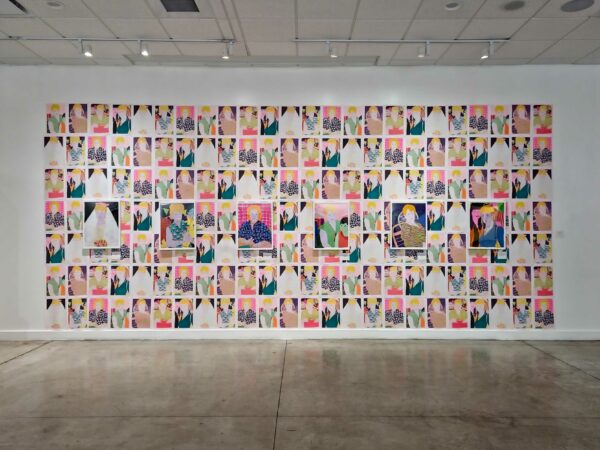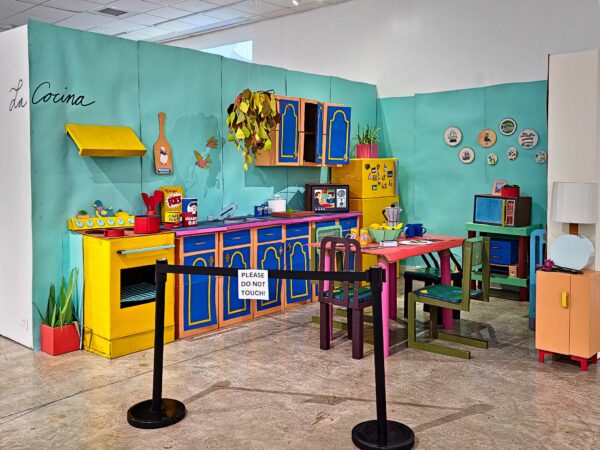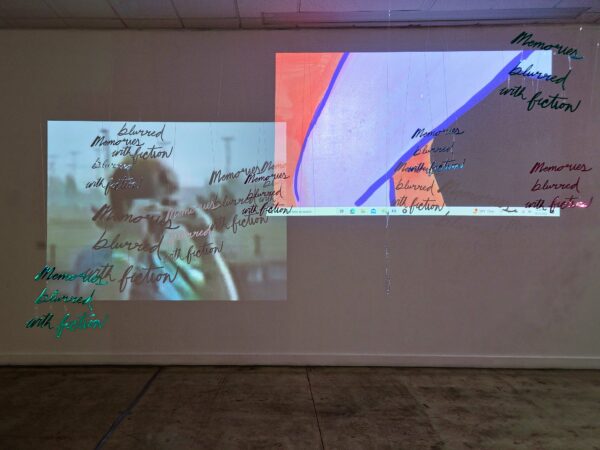
Alexandria Canchola, “Abuelita Series,” installation view in “Memories Blurred with Fiction” at the Brownsville Museum of Fine Art.
In a space filled with ambient lighting and questions about purpose, Alexandria Canchola provides viewers answers in her show, Memories Blurred with Fiction. Since becoming familiar with Canchola through Her.mosa collective’s public works throughout Brownsville and her publications as a University of Texas Rio Grande Valley alumna, I was excited to see her work in the Brownsville Museum of Fine Art’s (BMFA) North Gallery. Memories Blurred with Fiction seems to be a continuation of Yours to Keep, Para Ella, ¿Pero Eres Felíz? But Are You Happy? and Typecast (previous exhibitions by Canchola); the show is a step foward, marking evolution and progress. The exhibition’s name comes from the eponymous video installation that bookends it.

Alexandria Canchola, “Queen Painting,” installation view in “Memories Blurred with Fiction” at the Brownsville Museum of Fine Art.
At the entrance of the exhibition, there are small gouache paintings on wood panels depicting objects that either remind Canchola of her Conchita (grandmother), or are things her Conchita owned. My eye was not initially drawn to these images, outside of the fact that they lined the sides of the vinyl exhibition title and statement. I was, however, immediately drawn to Canchola’s Abuela Series installation. This work is comprised of a wall filled from top to bottom with risograph prints, upon which are hung illustrative gouache paintings, which depict her Conchita from her most objectively beautiful to her most vulnerable. The works are painted and toned in a blushing lavender color that allows us to view Conchita outside of her identity as a woman of color and instead strictly on the terms of her role as a woman. The sheer volume of works is a very smart way of showcasing multiple sides of Canchola’s Conchita, and helps emphasize the importance of her many roles.
Across from the installation is a wall full of larger-scale gouache paintings depicting everyday moments of Canchola’s childhood and her Conchita’s life, all surrounded by winding vinyl text that discusses memory and life. These paintings provide movement and peek into a certain time, giving off a nostalgic atmosphere. Canchola’s exhibition statement lays out her intentions to use her Conchita as a vessel for memories and cultural gender roles, to use the objects from Conchita’s life to establish a true self, and to explore the “connection[s] between memor[ies] and possessions” through this very pivotal figure in Canchola’s life. When looking at the risograph installation and the paintings hung on it, it is hard to see this connection. Canchola’s use of her Conchita as a vessel and these objects feel very separate as works, and seem only connected through this idea of what her Conchita embodies. That was, until I made my way to La Cocina.

Alexandria Canchola, “La Cocina,” installation view in “Memories Blurred with Fiction” at the Brownsville Museum of Fine Art.
In a “blink and you’ll miss it” moment, Canchola prepares you for La Cocina with a smaller installation with the fitting name of Squeezed Between Them. This small installation ties in Canchola’s gouache paintings with a small painting of her Conchita and Abuelo sitting on a couch next to children and paperwork by incorporating into the composition a pair of brilliant green plants in red pots. This piece is very intimate and uses color and text beautifully. The bright greens and reds allow for the figures of her family, in cool tones, to come forward; the work is an example of an excellent use of color theory. The text above the painting compresses it and gives the squished feeling of people squeezing next to one another. You can easily miss this work, and at the same time also miss her Conchita, who is painted in her usual blushing lavender tone, which can get lost in the background. This sense of “getting lost” does a wonderful job of showcasing Canchola’s ideas about how Conchita could become enveloped in her role as a mother, abuela, and homemaker.

Alexandria Canchola, “La Cocina” (detail), on view in “Memories Blurred with Fiction” on view at the Brownsville Museum of Fine Art.
Moving to La Cocina, I was taken aback. I was aware that everything — the entire kitchen — was to scale, but it was still surprising. There was so much detail that if you did not spend time with, or in, the installation, you could easily miss something. While I was in the piece, other museumgoers noted they were very impressed with Canchola’s use of cardboard and paper to make something so intently. One visitor even shared their thoughts with me, saying she was refreshed by the piece, and stopped to call a friend over so they could take a moment with the work. They stopped and stared in awe.
By taking humble materials and transforming them to create a beautiful piece of work, the installation took me back to my childhood of sitting in my grandmother’s kitchen in Harlingen, Texas. I was right there again, playing with my cousins and watching my mother and aunts help my grandmother prepare side dishes while my uncles were right outside our little screen backdoor, overcooking fajitas on the grill. I very much agree with my fellow visitors’ sentiment. You sometimes see paper and cardboard painted and drawn on, and treated as a mere surface on which to create, but the scale of Canchola’s installation shows the care the artist took to reproduce her grandmother’s kitchen, drawing on memories that were formed when the pair spent time there together.

Alexandria Canchola, “Memories Blurred with Fiction,” installation view in “Memories Blurred with Fiction” at the Brownsville Museum of Fine Art.
Leaving La Cocina you are met with Canchola’s But Are You Happy? print installation. The work takes imagery from the small gouache paintings: one portrait of Conchita, as well as glimpses of works from ¿Pero Eres Felíz?. This installation is another “blink and you’ll miss it” moment before stepping into Memories Blurred with Fiction, an installation made of acrylic, mirrored lettering layered over two video projections. One video depicts home movies of Canchola’s abuela, showing how she interacts with the people around her, including a young Canchola and the camera/audience. The second video, which plays in tandem and overlaps with the home videos, depicts detailed shots of the gouache works Canchola has been honing throughout her career.
The way the videos interact with each other takes me back to that feeling of “separate works” I had upon entering the exhibition. It was interesting to see the interplay of words and images in the piece, but it felt a bit flat. The video work seemed out of place in the nostalgia-infused installation I had just walked through. Seeing Conchita in action was a great opportunity — I couldn’t take my eyes off her. However, I think it isn’t the piece with which to end the exhibition. Perhaps the narrative placement of the work was more dependent on the physical necessities of the projector, but I think La Cocina would have worked better as a bookend to the show.
When stepping away from Memories Blurred with Fiction, I was met with more small gouache paintings: one of a television playing the telenovela Luz Clarita, and the other of what may be Conchita’s powder puff, and two of Canchola’s early works from Typecast, depicting beaches full of people enjoying their time in the sun. The exhibition ends with those paintings and vinyl lettering echoing “Memories Blurred with Fiction.”

Alexandria Canchola, “Peachy Beachy Sunny Bikini,” on view in “Memories Blurred with Fiction” at the Brownsville Museum of Fine Art.
All in all, I felt underwhelmed by the exhibition. Maybe there wasn’t enough breathing room between pieces, which led to hidden gems being overlooked. It may have been the dim lighting of the BMFA, but it all felt muddled and muted. It’s difficult to say what exactly was the main issue, but it felt contradictory to what Canchola’s work was trying to say. As an artist, you have to work with the space you are given to exhibit in, and I believe Canchola did just that. However, not every space is the right for you to show your work. I was left with the feeling that Canchola’s work needed more attention than what was given.
With that said, any chance to see Canchola’s work in person is an opportunity you mustn’t pass up. Her exhibition will be on display at the Brownsville Museum of Fine Art through January 12, 2024. For more about the show, go to the BMFA website.


